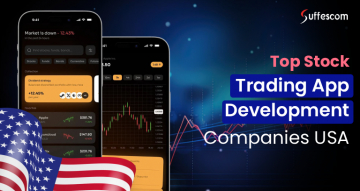Restaurant Mobile App Development in UAE | Saudi Arabia Cost

Restaurant mobile apps in 2025 will become very important in the Gulf, particularly in the UAE and Saudi Arabia. From table booking to delivery of food, mobile-first dining is not an option anymore because it is what customers expect today.
In the UAE, an international expat community with a relatively high level of smartphone penetration increases the demand for premium eateries. Cities such as Dubai and Abu Dhabi are progressive in terms of innovative options, such as food recommendations with the help of an AI, dine-in reservation options, and more.
At the same time, Saudi Arabia is experiencing a high rate of foodtech transformation through the Vision 2030. Hyperlocal delivery and affordable food ordering applications have been on the rise due to the young population and increasing digital infrastructure. Even Riyadh and Jeddah are in full swing with startups that are supported by the Public Investment Fund (PIF) coming onto the scene.
Although the two markets are doing well, they target different markets. The UAE concentrates on luxury, multilingual, and tourist-integrated applications. In Saudi Arabia, there is a preference towards mass-market and value-focused culturally-oriented apps.
Together, a combination of these changes makes the Gulf one of the most active markets for restaurant app development in 2025.
Food Delivery & Restaurant Tech Adoption in UAE vs Saudi Arabia
The online food delivery market in the Gulf is quickly transforming, and its revenue is expected to reach $18.24 bn in 2025. With this upsurge, both the UAE and Saudi Arabia are looking forward to restaurant tech, but in distinctive ways. Such differences are significant in creating apps that should appeal to individual markets.
UAE Market Trends
The UAE has a 95% mobile phone penetration rate, making it one of the highest mobile-connected countries worldwide. Customers now want comfort, quickness, and quality. Furthermore, eateries are now incorporating their apps with a wider range, like tourism and hospitality, delivering hotel-dining access and event promotions.
Particularly, the city of Dubai has boasted successful experiments with premium features of apps, including Apple Pay and PayBy integration, AR-based menu preview, and premium loyalty programs.
KSA Market Trends
Saudi Arabia is going through an evolution that is foodtech, highly influenced by Vision 2030 and supported by funding from the PIF (Public Investment Fund). Moreover, there is a strong momentum besides online-only dark kitchens, particularly in rising tier 2 cities like Abha and Dammam.
Restaurant app development is dominating the market with customers leaning towards features like chat-based ordering, regional food filters, and different payment options, including COD (Cash on Delivery). The youth is also driving high demand for mobile-first and value-driven choices that will change the dining experience.
Popular Food App Ecosystems
In the UAE, dine-in, takeaway, or loyalty features of such applications as Talabat, Zomato, and Careem's DineOut have established a strong ecosystem. In Saudi Arabia, platforms like HungerStation, Jahez, and Mrsool pay more attention to hyperlocal delivery, an Arabic-first experience, and local dishes. The difference in consumer attitude and the ability of the applications make it essential that the business customises its offerings to suit every market. Furthermore, to compete in the UAE or Saudi Arabia's rising foodtech space, your app needs to have a mix of core functionalities and better add-ons made for regional preferences.
| Popular Apps | Region | Features |
| Talabat | UAE | Real-time order tracking, dine-in, and takeaway options |
| Zomato | UAE | Instant table availability checks, easy booking cancellations, and calendar reminders |
| Careem | UAE | Restaurant filters, ride integration, and loyalty rewards |
| HungerStation | Saudi Arabia | User-friendly navigation, chat ordering, and multiple payment methods |
| Jahez | Saudi Arabia | Order tracking, customer feedback management, and sales reports |
| Marsool | Saudi Arabia | Personalised delivery experience, AI chatbot integration, and multi-booking options |
10 Features Your UAE or Saudi Arabia Restaurant App Needs
While developing a restaurant app for the UAE or KSA, the best feature integration is required. Here are the 10 features that your restaurant should have to fulfill the requirements for both markets.

Core Features of Restaurant App
Online Ordering (Pickup + Delivery)
This makes the basis of any restaurant application. You have to make sure that the user can make orders for both home delivery and in-store pickup with only a few clicks. Its interface must indicate the approximate time to prepare, the delivery timeframe, and stock levels of items. In cities such as Dubai and Riyadh, customers tend to switch between dining in and takeaway, and hence, the two must be smooth.
Live Order Tracking
Real-time GPS-based tracking is now a standard feature. It helps users to trace where their order is in terms of preparation, dispatch, and delivery. In Saudi Arabia, where food delivery apps are prevalent even in Tier 2 cities, this feature helps to build trust and lower customer support queries.
Multi-language Support (Arabic + English)
Accessibility has critical importance in language. In the UAE, your app should support at least two languages, English and Arabic, and preferably Hindi or Tagalog in order to support expat users. The Arabic-first approach and culturally appropriate design increase the engagement with the design and adherence to the local standards in Saudi Arabia.
Push Notifications
Timely and customized push notifications aid in increasing engagement and uplifting sales. It can include discounts, order updates, and reminders for reordering, in the UAE and KSA, where mobile usage is high. Right-timed promotions can enhance conversion rates and brand recall.
User Profile & Order History
A user profile allows users to handle their personal information, addresses, and much more. Additionally, customers want a feature to view past order history that simplifies the ordering process and allows personalized recommendations.
Smart Add-Ons
Table Reservation with Dynamic Time Slots
This functionality is very important for fine-dining restaurants and busy restaurants. It enables the customer to view real-time slots available and book them. The integrated reminders and the auto-canceling options enhance the efficiency of users and restaurant staff overall.
AI-Powered Food Suggestions
With Artificial Intelligence, it is possible to analyze user history, weather, the time of the meals, and the trending dishes to recommend. This aspect raises the possibility of upsells and makes the user feel more personalised because, in a competitive environment, differentiation is crucial.
Loyalty Programs
Rewarding repeat customers with points, exclusive deals, or VIP tiers encourages repeat business. In the UAE, luxury experiences can be associated with the presence of loyalty features. Gamified reward systems have found a lot of traction among the younger, mobile-first population in KSA.
In-App Feedback & Ratings
Allow users to post their experience with particular dishes, delivery, and service. Structured ratings and photo reviews help make the restaurant more trustworthy and draw attention to menu items that are performing well. This feedback also provides restaurant owners with direct insights into customer satisfaction.
Payment Gateway Integration
A checkout needs to be flexible. You must enable a variety of international payment methods and local payment methods on your app, like Apple Pay, credit/debit cards, PayTabs, STC Pay (popular in KSA), and Tabby or PayBy (popular in the UAE). Even in the cities of the KSA, it is significant to provide cash on delivery.
Types of Restaurant Apps to Build
The restaurant app that you develop must suit your business model, audience, and dining behaviour in a specific region. The UAE and Saudi Arabia offer very different opportunities when it comes to restaurant app development. Here are some custom-fit app types as per the market:
UAE-Oriented Models
There are several types of restaurant apps that are popular in the UAE. Let’s discover some of them.
Fine Dining Reservation App
It is made to fit in the upscale restaurants where it is necessary to book a table. They may come with such features as:
- Real time availability of time slots.
- Menu previews with cost.
- Rewards for the regular diners.
The model is quite successful in cities such as Dubai or Abu Dhabi, where people enjoy a luxurious dining experience at the best restaurants.
Gourmet Food Subscription
Gives the user an option to subscribe to weekly or monthly customer meal plans at premium restaurants or cloud kitchens.
- Perfect for individuals who are working professionals as well as health-conscious expats.
- Can include flexible delivery scheduling and dietary filters.
Cloud Kitchen Order Management
This type of restaurant app is built for cloud-only or delivery-first kitchens that operate with no dine-in facility.
- Real-time order management.
- Integration with delivery partners.
- Kitchen-side dashboards for multiple brands under one platform.
Saudi Arabia-Oriented Models
Like the UAE, there are also some types of restaurant apps that users are inclined towards in the KSA. Let’s delve into the major ones:
Hyperlocal Delivery App
Aims to deliver food within a limited geographic radius, generally within a single city or district.
- Optimized for fast delivery.
- Ideal in Tier 2 and Tier 3 cities.
- Integrated with local restaurant partnerships and COD choices.
Arabic Cuisine Aggregator
It is a type of app that brings different local cuisines and traditional food vendors in one place.
- Filters for region-specific dishes (Najdi, Hijazi, etc.).
- Arabic-first interface with culturally relevant imagery.
Mass-market food ordering app (for solo entrepreneurs)
A simplified app that enables small restaurant owners or home-based chefs to post menus, accept orders, and coordinate deliveries.
- Low setup costs, simple integration.
- Great for independent operators looking to go digital without high overheads.
Restaurant App Development Cost Breakdown (2025)
It is critical to learn about the budget for your restaurant app development in Saudi Arabia and the UAE. Prices are determined based on the complexity of the app, its features, and regional needs. Let’s explore the cost drivers and estimated development expenditure in the UAE and Saudi Arabia in 2025.
App Complexity
The complexity of your restaurant app highly impacts the overall app development cost. Balancing out between important functionalities and user-friendliness is crucial. Furthermore, this complexity is divided into three major sections, including simple, mid-level, and advanced restaurant apps. While opting for a simpler design and basic features usually reduces cost, it increases the chance of our app not making a mark in the market. On the other hand, the mid-level and advanced provide better functionality and design but come with an increased price and time, which can make your app stand out. Below is a table that helps you understand the overall restaurant app development cost based on complexity:
Restaurant App Development Cost Comparison
| App Type / Complexity | UAE (in AED) | Saudi Arabia (in SAR) | (In USD) |
| Basic Restaurant App | AED 36,700 – AED 55,000 | SAR 33,750 – SAR 52,500 | $10,000 – $15,000 |
| Mid-Level App (Add Loyalty, Multilingual) | AED 58,700 – AED 91,750 | SAR 56,250 – SAR 86,250 | $16,000 – $25,000 |
| Advanced App (Delivery, Real-Time Tracking, POS Integration) | AED 110,000 – AED 220,000+ | SAR 93,750 – SAR 206,250+ | $30,000 – $60,000+ |
| Monthly Maintenance & Updates | AED 1,835 – AED 7,340 | SAR 1,500 – SAR 5,625 | $500 – $2,000 |
UI/UX Design Quality
The design is a factor that is very important in the development and usage of your restaurant app. In the UAE, where digital experiences often match high-end dining, the expectation is for elegant interfaces. These encompass personalized visuals, smoothly transitioning, and support for languages like Arabic and English. In contrast, Saudi Arabia would require the design to be adapted to the right-to-left RTL layout, culturally acceptable designs, and easier flows. These extra layers of design require much more time and money to implement.
Number of User Roles (Admin, Kitchen, Delivery, Customer)
The greater the number of user roles your app requires to accommodate, the more intricate and lengthy the development process becomes. An ordinary food ordering app may only need an interface with a customer. However, most modern restaurant platforms require separate modules for kitchen workers, delivery drivers, administrative staff, and customers. Every position has its workflows, rights, and UI screens. The creation and development of all these multi-experiences contribute to both front-end and back-end complexity, which increases restaurant app development expenses.
Backend Infra (real-time updates, cloud hosting)
Real-time functionality has become a standard feature of restaurant apps in the GCC. Live order tracking, dynamic table reservations, inventory syncing, and instant notification requests are the features that depend on a powerful backend design. Cloud platforms as Firebase, AWS, or Google Cloud can provide better adaptability, but at the cost of extra expenditure and upkeep. The requirement for data processing and scalable performance is essential, especially in cities like Dubai and Riyadh, where users are most active during peak mealtime hours.
Compliance (VAT invoices, Arabic RTL)
The UAE and Saudi Arabia each have unique compliance requirements, so when building your app, you must integrate these requirements into its core. These include VA-compliant invoicing, adherence to data protection laws, and presenting content in Arabic with proper right-to-left text adjustment. KSA needs that the restaurant apps must incorporate cash-on-delivery (COD), whereas in the UAE, the customers require integration with payment services as Apple Pay, STC Pay, etc., as well as Buy Now Pay Later (BNPL) systems. Fulfilling these localized expectations often requires extra development, third-party integration, and rigorous testing.
Platform and Device Strategy
Your decision between creating a native app or using a cross-platform framework can highly influence the budget. Native development can provide the best performance and better integration within the system, which suits apps that have high quality or are enterprise-level. However, it requires iOS and Android codebases independently, making it more expensive and taking up more time to develop. Cross-platform tools, in turn, offer quicker deployment and can be used in the majority of small to mid-level restaurant applications. However, they are not well-suited for high-end functionality.
Let’s Launch Your Restaurant App Together!
Connect with our mobile app development company today to get a free project roadmap.
Best Tech Stack for Restaurant Apps
Your restaurant app is based on your tech stack. If you are developing a solution that will take the multilingual high-end dining market in the UAE, or the fast-growing foodtech market in Saudi Arabia, then proper selection of the frontend, backend, database, and integration technology will result in a successful and scalable solution.
Frontend
1. Flutter / React Native (Cross-Platform)
- Best for startups and fast MVPs
- Write once, deploy on both iOS and Android
- Saves cost and development time
These frameworks are well-suited for businesses that require testing the market before scaling up.
2. Native (Swift for iOS, Kotlin for Android)
- Better performance and UX
- Preferred for high-end, brand-sensitive apps
- Allows advanced hardware integration (camera, GPS, Apple Pay)
Best suited for premium apps targeting luxury dining or advanced logistics for delivery.
Backend
1. Firebase
- Real-time syncing and push notifications
- Built-in analytics and crash reporting
- Fast to deploy and scalable
Beneficial for delivery-first apps needing instant updates across multiple roles (customer, kitchen, driver).
2. Node.js
- Lightweight and efficient
- Handles high traffic and simultaneous orders
- Great for modular, microservice-based architecture
Works well for applications expecting thousands of concurrent users, like mass-market apps in KSA.
3. Django
- Secure and structured
- Excellent for handling VAT invoices and form validation
- Suitable for apps needing strong backend logic
Good fit for apps with detailed compliance or admin-heavy workflows.
Database and Real-Time Support
1. Firestore (Firebase)
- Cloud-hosted, NoSQL, real-time database
- Syncs instantly across roles (admin, delivery, customer)
- Scalable as your restaurant grows
2. MongoDB
- Flexible data models
- Ideal for complex, multi-brand restaurant chains
- Compatible with Node.js for efficient API development
Third-Party Integrations
1. Payment Gateways
- UAE: Apple Pay, PayBy, Tabby
- Saudi Arabia: STC Pay, HyperPay, MADA
- Global options: PayTabs, Stripe
Choose based on regional popularity and user trust.
2. POS Integrations
- Oracle MICROS, Square, Toast
- Syncs menus, prices, and order data in real-time
- Essential for hybrid models (dine-in + delivery)
3. Notifications & Messaging
- Firebase Cloud Messaging (FCM) for push notifications
- Twilio or SendGrid for SMS/email order confirmations
- WhatsApp API integration (especially popular in KSA)
These technologies in combination make a solid foundation for restaurant app development in UAE and Saudi Arabia.
What Should Be in the Admin Panel of a Restaurant App?

A well-designed admin panel is the control center of your restaurant app. It enables restaurant owners and managers to make instant decisions and scale up operations. Let’s explore its must-have features that you should incorporate into your restaurant app:
Must-Have Modules
1. Order & Inventory Management
- Track incoming orders instantly.
- Handle item availability, food preparation time, and out-of-stock items.
- Sync inventory with the POS system to eliminate the requirement for manual updates.
This module guarantees better coordination between the kitchen and the front-end app, particularly for cloud kitchens.
2. Menu Builder
- Add, edit, or remove dishes easily.
- Upload images, descriptions, prices, and tags.
- Schedule time-based menus
There should be an option to modify the menu because when it comes to seasonal offers, festivals, and location-differentiated needs, it helps to increase sales.
3. Real-Time Sales Dashboard
- Monitor daily, weekly, and monthly sales.
- View the highest-ordered items, peak hours, and order sources.
- Compare branches or delivery.
A dashboard gives decision-makers the option to review performance, helping them adjust or modify marketing, pricing, and staffing approaches.
4. Coupon/Promo Code Manager
- Create discount codes for delivery, dine-in, or special occasions.
- Limit usage by time, region, or order amount.
- Track redemption rates.
Promotions are a core growth driver, especially in competitive KSA cities where food apps frequently offer localized deals.
5. Delivery Partner Tracking
- Monitor delivery staff in real-time via GPS.
- Assign orders manually or auto-assign based on proximity.
- Track delivery speed and customer ratings.
This is essential for restaurants managing their own fleet or working with third-party drivers in densely populated areas.
Adapting Apps to Local Culture & Behavior
In the Gulf region, a restaurant app should feel native, not only in terms of language, but also in design, payment systems, graphics, and timing. The UAE and Saudi Arabia have a rich culture, but their user behavior, expectations, and the use of technology largely differ.
For UAE
1. Multilingual UX (English, Arabic, Hindi, Tagalog)
The UAE has a very diverse population in the world. A restaurant app, in this case, should be able to serve the expats of the South Asian countries and the Middle East.
- The primary ones should be English and Arabic, and switching between them should be easy.
- Incorporating languages such as Hindi and Tagalog can make a difference in adoption, mainly for drivers and domestic users.
- Fonts and UI designs need to be readable in each and every language, and when changing between left-to-right (LTR) and right-to-left (RTL) interfaces.
2. Integration with tourism deals, table bookings
Tourism is highly integrated into the UAE's economy. Your restaurant application can increase traction by syncing with tourism platforms and hotel services.
- Allow tourists to discover the highest-rated foods or restaurants around the main attraction places (such as Burj Khalifa or Yas Island).
- Collaborate with hotels and resorts to deliver in-room ordering through the restaurant application.
- Add geolocation-based pop-ups for short-period dining offers during tourist seasons or large events.
3. Integration with Expo events, hotel dining
The dining out culture in the UAE is more of a status symbol and a lifestyle. Dubai especially leads in luxury dining, brunch culture, and food fusion experiments.
- Build a restaurant app with features to support chef menus, pre-bookings for exclusive restaurants, or VIP reward programs.
- Features like valet parking booking and table-side ordering can improve the experience for upscale users.
- Even casual apps should reflect a polished UI and smooth flow to match user expectations in a premium setting.
For Saudi Arabia
1. Arabic-first UX
In Saudi Arabia, a well-optimized Arabic experience is not optional, it is a must.
- The entire restaurant app must be set to default to Arabic in terms of menus, help sections, and notification texts.
- The layout must be RTL, and it should also have smooth navigation.
- Tone and phrasing should convey cultural respect. Even minor copywriting details can impact the user's trust.
2. Islamic calendar-based promo scheduling
A restaurant app should leverage promo scheduling based on the Islamic calendar, particularly on regional festivals like Eid and Ramadan.
- The app should allow users to view and select dates according to the Islamic calendar.
- Promotional campaigns should be in accordance with local religious and cultural calendars.
- The app should offer an option to change between Islamic and Gregorian calendars.
3. COD (Cash On Delivery) & Local Wallet Integrations
The use of cards and mobile wallets is increasing at a very high pace, but cash-on-delivery (COD) is still particularly prevalent in Tier 2 and 3 cities.
- The app must have various payment options: MADA, STC Pay, Apple Pay, and COD.
- Your restaurant app should provide real-time status on payment completion or refunds.
- The application should have an option to save payment details so that users do not have to enter them every time.
Step-by-Step Guide To Develop Your First Restaurant App

Let’s explore the step-by-step process to build a restaurant app that can stand out in the market:
Step 1: Define Business Model
Start with precisely outlining your app’s scope. For example, are you building an application for both dining and delivery services? Defining the scope of the business assists in selecting features, technology stack, and cost.
Step 2: Conduct Market and Competitive Research
In this step, examine your audience, which restaurant apps are doing well, and what local preferences you should incorporate into the app. Assessing all these things will help you create the best restaurant app.
Step 3: Choose the Right Features
Select the appropriate features according to your business goals and audience. Some important features include:
- Online ordering (pickup + delivery)
- Live order tracking
- Table reservations
- Loyalty programs
- In-app payments
- Ratings and reviews
Step 4: Select the Appropriate Tech Stack
The next step is choosing the right tech stack, which can fulfill your restaurant app needs. Also, make sure to choose based on the restaurant app development budget and scalability goals as well.
Step 5: Design for Local User Experience
At this stage, the design of the restaurant app is created according to local user preferences, as this increases retention of the restaurant app in markets like the UAE and Saudi Arabia.
Step 6: Restaurant App Development
This step involves the development of the application, in which all the features and functionalities are integrated that have been decided upon from the beginning, including the admin panel, user panel, and driver panel.
Step 7: Test the App
After the development phase, the testing phase starts, during which the app is completely tested to find and resolve bugs before going live.
How to Launch and Promote Your Restaurant App
After the restaurant app development, the crucial phase comes, which is how you launch and market it, that determines real success. Both the UAE and Saudi Arabia have different marketing environments, consumer patterns, and cultural chronologies. Localized approaches throughout the regions may assist the company in building sustainable trust and loyalty. Let’s discover some launch tips for both the UAE and Saudi Arabia.
UAE Launch Tips
1. Use Instagram Influencers, Especially in Dubai
Instagram is one of the most used platforms in the UAE, especially in Dubai,
- Ask the micro and macro influencers to show your app features, like one-click table reservations or premium delivery.
- Influencer-led campaigns, particularly in weekends or tourist seasons, often perform best.
2. Promote dine-in + loyalty hybrid features
A lot of the UAE customers appreciate the idea of using a combination of dining in while getting digital benefits.
- Market app features where people receive rewards when they make a delivery or dine in.
- Balance the traffic by giving off-peak hour bonus points or discounts on bookings.
3. Partner with travel platforms & malls
The UAE is highly integrated with the tourism and retail sectors.
- Partner with mall food courts or hotel chains to provide app-exclusive ordering or pre-booked seating.
- Put QR codes on concierge desks, or taxis, or adjacent to the travel kiosks, so that additional downloads follow.
Saudi Launch Tips
1. Snapchat and TikTok influencer marketing
In KSA, particularly among the young generation, Snapchat and TikTok are utilised heavily.
- Collaborate with creators to make short, catchy videos on the app’s features.
- Promote fast delivery, COD options, and family meal bundles.
2. SMS + push during Ramadan and local holidays
Ramadan, Eid, and Saudi National Day are the times when there is high food ordering demand.
- Schedule promotional SMS and app push notifications around Iftar times.
- Include Islamic calendar integration for seamless promo scheduling.
3. Collaborate with local cafes for app-only offers
Develop early traction by working with popular cafes and restaurants.
- Provide discounts or combo deals only available through the app.
- Integrate referral programs with wallet credits to attract early users and encourage them to tell about the app.
What Happens After Restaurant App Launch?
Launching your restaurant app is just the beginning. Growth needs to be sustained through consistent performance tracking, user attraction tactics, and intelligent upscaling methods. It is a dynamic market, such as the UAE and Saudi Arabia, where food habits change rapidly and there is intense competition. Post-launch planning can be a major factor in your app's value in the long run.
Key Metrics to Track
1. Retention Rate
Retention means the users who are continuously using the app for a particular period after the initial installation. A high retention rate means customers find your app enjoyable and valuable for various services.
2. Delivery Time
Timely delivery is a key driver for customer satisfaction. Keep track of average delivery times, failed or delayed orders, and integrate analytics with delivery fleet management.
3. Referral Conversions
Word-of-mouth is powerful in both the UAE and KSA markets. Check how many users join through referral codes or shared links. Moreover, reward top referrers to gain more traction.
4. Average Order Value
It is the average amount a person spends on each order. Tracking it helps to upscale the business without increasing the customer base. Moreover, it will help you budget wisely and track revenue.
Scaling Strategies
1. Add multilingual chatbots
Support customers in Arabic, English, Hindi, or Tagalog through in-app AI chatbots. They handle common queries like order status and payment issues to reduce customer support load while offering 24/7 service.
2. Franchise dashboard with custom modules
Dashboards with custom modules help franchises to handle their operations, keep track of performance, and assess essential tools that assist them in scaling up.
3. Introduce predictive food analytics (AI)
Utilise artificial intelligence to anticipate user behavior. Recommend meals based on weather, past orders, or local trends. Moreover, optimize kitchen operations by forecasting peak hours and ingredient needs.
Restaurant App Development UAE vs KSA – Which Is Better?
Both the UAE and Saudi Arabia present massive opportunities for restaurant app development, but they differ in scale, audience, and digital maturity. UAE is most appropriate for high-quality, multilingual, and fully-featured apps serving a diverse population with high spending capacity. It is perfect when it comes to companies that need to develop sophisticated digital dining, have tourism integration, and provide luxurious service.
Saudi Arabia, on the other hand, is a high-volume, fast-growth market driven by a young, mobile-first population. Foodtech-heavy investment has enabled the entry of localized, value-driven applications, which are part of Vision 2030. If your goal is rapid user adoption, hyperlocal delivery, and culturally first food services, Saudi Arabia provides the scale and opportunity to grow fast.
If you still have any doubts, connect with Suffescom today to get more insights on restaurant app development.
Build your first Restaurant App today!
Partner with our expert mobile developers who understand GCC markets, foodtech regulations, and user behavior.
FAQs
How much does it cost to create a restaurant app in UAE?
The cost to create a basic restaurant app in the UAE can range $10,000 to $25,000, whereas a fully-featured restaurant application can be up to $60,000, based on the number of features and integrations.
What are the key features of a restaurant app?
The notable features of a restaurant app include making orders online, live tracking, menu control, loyalty programs, table booking, multi-lingual settings, and secure payment integrations.
Which payment gateways are used in UAE and Saudi apps?
Popular gateways that are utilised in UAE and Saudi apps are PayTabs, Network International, Apple Pay, HyperPay, STC Pay, and Tap. Integration is based on your business structure and targeted market.
How long does it take to develop a restaurant app?
The time needed to create a restaurant application in UAE or Saudi Arabia varies depending on the set of features, platforms, and APIs to be employed, but is estimated in a range of 2-4 months.
What tech stack is best for restaurant apps in the Middle East?
The best tech stack for restaurant apps in the Middle East includes:
- Frontend: Flutter or React Native
- Backend: Node.js or Django
- Database: Firestore or MongoDB
How do I promote my restaurant app in Saudi Arabia?
To promote your restaurant app in Saudi Arabia, utilise influencer marketing, operate app-only offers, and collaborate with influencers to create hype.
Are loyalty programs effective in UAE food apps?
Yes, loyalty programs are effective in UAE food apps because customers react well to cashback, loyalty points, and exclusive offers.
What are some restaurant app ideas for Dubai?
Some restaurant app ideas for Dubai include luxury dining booking apps, vegan food finders, cloud kitchen dashboards, and dining with hybrid platforms for travellers.
What is the cost of food delivery app development in Saudi Arabia?
The cost of food delivery app development in Saudi Arabia is between $9,000 and $55000. The prices differ depending on the complexity, the payment gateway, and the multi-regions delivery configuration.
Is cash on delivery (COD) supported in Saudi Arabia apps?
Yes, cash on delivery (COD) is supported in Saudi Arabia apps because Tier 2 cities and first-time users prefer it.
Can I connect my restaurant POS to the app?
Yes, you can connect popular point-of-sale systems, such as Square, Oracle MICROS, or custom POS, to synchronize your orders, stock, and sales directly with your app dashboard.
Can I make a restaurant app in Arabic and English?
Yes, you can make a restaurant app in Arabic and English, as it is very important for the UAE and Saudi Arabia. Furthermore, your app should support both RTL and LTR text with an easy switching option.







